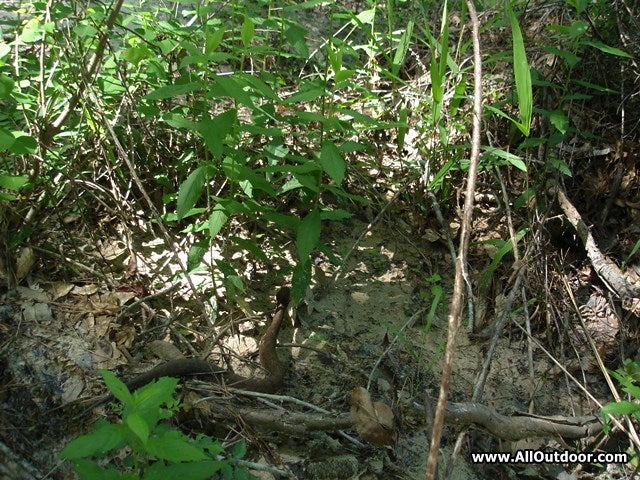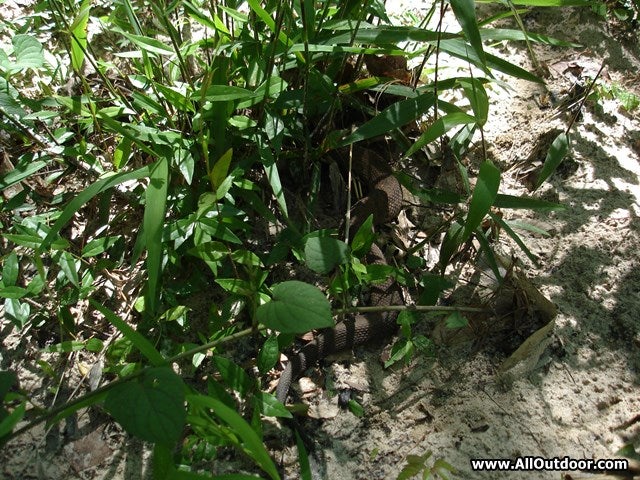Differences Between a Water Snake and a Water Moccasin
Kevin Felts 04.19.18

Weather is starting to warm up, people are heading into the woods for various outdoor activities, and snakes are sunning themselves with the warm spring sunlight. If someone spends enough time outdoors, sooner or later they will encounter a snake. First thing most people think about when seeing a snake is it the snake is venomous.
Copperheads and Coral Snakes are usually easy to identify. However, various non-venomous snakes are little more difficult to identify. One of the snakes which is easy to confuse with a Water Moccasin (Agkistrodon piscivorus) is the Water Snake (Genus Nerodia). Their are numerous different types of water snakes spread all through the United States. Some are easy to tell from a Water Moccasin, others almost look identical.
Certain features mark differences between the Water Moccasin and the Water Snake, such as pupils being round or vertical. Personally, I do not care to get close enough to look a snake in the eye.
Coiled When Threatened
Over the years one of the characteristics I have noticed between the Water Moccasin and Water Snake, is the Water Moccasin will coil when it feels threatened. If someone walks up on a Water Moccasin, chances are it will be coiled and ready to strike. It would not be uncommon for a Water Moccasin to stand its ground in the face of danger.
Several years ago I walked up on a Water Moccasin near a creek. It sat there for maybe15 minutes while I took pictures and looked it at. When the snake finally had enough, it slithered into a hollow tree.
Water Snakes on the other hand, just about every one I have ever seen (dozens) tried to flee when spooked. They will typically try to blend in with foliage, or seek refuge. While walking down a creek a Water Snake slithered right past me and went up under a washed out bank. I just happened to be between the snake and its home.
Triangular Head
Some people say, “Just look at the head; venomous snakes have a triangle head.” However, some Water Snakes can look like they have a triangle head. Others may have no difference in the width of their head and head and body.

The Cotton Mouth will have a head shaped like a block. Not only it is triangle shaped, it will be thicker than the Water Snake. Typically, the head of a Water Snake will not be as thick as the Cotton Mouth.
April 2018, my dogs and I were walking near a creek when we came upon a Water Snake with its head in a clump of grass. I got the dogs away from the snake, then tried to get a look at its head. When it slithered out of the grass and towards a pile of tree limbs, its head had a slight triangle pattern to it. However, the triangle was not as well defined as a Cotton Mouth.
With the snakes head in the clump of grass, it could have been easily confused with a Water Moccasin. The body was fatter than what someone may expect from a Water Snake, but it was not displaying typical Water Moccasin behavior.
Final Thoughts

Please do not go around picking up snakes because you “think” you know what kind they are. In this article we talked about snake behavior. However, just because a snake acts a certain way does not mean it is is a certain type.
For example, during the spring of 2017 I came across a Hognose Snake. They are non-venomous and pose no danger to humans. Did I pick it up? Nope. It was left alone to go on its merry way.
Someone comes across a snake: Stay at a safe distance, take some pictures, then go on your merry way. Chances are you are in the snakes home. There is no reason to harm a snake for doing what snakes do.
Even if I find a chicken snake in the chicken house I will sometimes leave it alone. I would rather have a harmless snake in the chicken house than rats and mice.
I am sure the readers will have some suggestions on how to tell a Water Snake apart from a Water Moccasin.